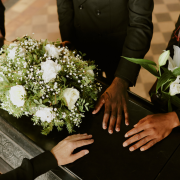What to Include in a Memorial or Visitation Service
Why These Moments Matter
A memorial or funeral visitation doesn’t need to follow a script. There’s no standard template. No right way to do it.
But when it’s done well, it creates space — for grief, for memory, and for connection.
Some families keep it quiet and simple. Others bring food, photos, and a slideshow that makes people laugh through their tears. The format doesn’t matter as much as the feeling. And that comes from what you choose to include.
If you’re planning a memorial or funeral visitation and aren’t sure what goes into it, this guide can help.
What’s the Purpose of a Memorial or Visitation?
Unlike a structured funeral service, these gatherings tend to be more flexible. There’s often no funeral casket present. Sometimes the burial or cremation has already happened.
The purpose is less about tradition and more about togetherness.
A funeral visitation is usually held before the funeral service, giving guests a chance to offer condolences and share memories in a quieter setting.
A memorial can happen days, weeks, or even months after a loss. It gives people time to travel, reflect, and participate in a way that feels less rushed.
Both formats are about remembering — not just the loss, but the life.
Key Elements You Can Include
What you include depends on the tone you want to set. Here are some of the most common — and meaningful — additions:
- Photos: Printed images, poster boards, slideshows, or digital frames.
- Poems or Readings: Funeral poems, quotes, song lyrics, or short stories. These don’t need to be religious unless that fits. Some of the most touching moments come from a simple line that meant something to them.
- Eulogies: A friend, partner, or family member can share reflections or tell a story that brings the room together.
- Music: Background playlists, live acoustic performances, or selected songs for specific moments.
- Food and Drink: From light refreshments to full meals — food has a quiet way of helping people feel at ease.
- Memory Tables or Keepsakes: More on that below.
Some families also display the funeral casket at a visitation, depending on timing and personal choice. Others place an urn with photos, candles, or flowers nearby.
How to Shape the Flow
Even a relaxed gathering benefits from gentle structure.
Here’s a sample timeline many families follow:
- Welcome or opening words from a family member, celebrant, or clergy
- Music or slideshow
- Readings or funeral poems
- A eulogy or personal reflections
- A moment of silence
- Time for guests to share stories (optional)
- Closing words
- Food and mingling
Funeral directors can help you manage the timeline, so you’re not carrying that responsibility while trying to grieve.
Creating a Story Through the Details
The most powerful funeral services feel personal — not just polished.
Think about what made them unique:
- Were they lighthearted or quiet?
- Did they love jazz, gardening, or motorcycles?
- What did people always say about them?
Reflect those things in small details — the music, the colors, the quotes. Maybe it’s a dish they always made, or a favorite hat placed on the memory table.
Sometimes the most meaningful funeral arrangements are the ones with the most heart, not the biggest budget.
Keepsake Ideas and Memory Tables
Memory tables help people connect in ways that feel natural.
Common items include:
- Photo albums
- Favorite books or worn-out tools
- Hobbies or crafts they were known for
- Quotes or printed funeral poems
- Candles or small mementos
- A guestbook or “memory jar” where visitors can leave notes
Some families offer take-home keepsakes. Bookmarks. Seeds. Magnets. Printed obituaries with a photo and quote. These small pieces often end up on fridges and nightstands — reminders that live on quietly.
Planning Ahead Helps More Than You Think
Some families choose to pre-arrange these elements as part of their funeral preplanning. It takes the burden off loved ones later and ensures the service reflects the person it’s meant to honor.
In your funeral preplanning conversation, you can specify whether you’d like a memorial, visitation, or full funeral service. You can even choose which funeral poems you’d like read or what kind of music should play.
If you’re someone who wants to shape your story in advance, this option might bring peace of mind.
How Tranquility Funeral Services Can Help
At Tranquility Funeral Services, we support families from planning through to the final goodbye.
That includes:
- Helping you choose between a visitation, memorial, or full funeral service
- Coordinating speakers, music, and timelines
- Setting up keepsake displays and memory tables
- Writing or printing obituaries and tribute materials
- Supporting any part of the funeral arrangements, including casket or urn decisions
Whether you’re planning something now or thinking about funeral preplanning for the future, our team of experienced funeral directors is here to help — with no pressure and no assumptions.
Speak with a planner or request our visitation guide to learn more.
Even small details can help a service feel more like them. We’ll help you bring those pieces together.










